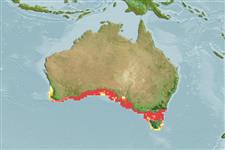>
Scombriformes (Mackerels) >
Arripidae (Australian salmon)
Etymology: Arripis: Latin, arripio, arripere = to take something suddenly.
More on author: Cuvier.
Environment: milieu / climate zone / depth range / distribution range
Ecologia
marinhas; estuarina bentopelágico; intervalo de profundidade 0 - 80 m (Ref. 6390). Subtropical; 27°S - 44°S
Eastern Indian Ocean: southern Australia from Western Australia to Victoria and Tasmania.
Comprimento de primeira maturação / Tamanho / Peso / Idade
Maturity: Lm ?, range 54 - ? cm
Max length : 96.0 cm SL macho/indeterminado; (Ref. 33839); common length : 65.0 cm FL macho/indeterminado; (Ref. 27977); peso máx. publicado: 10.5 kg (Ref. 27977); idade máx. registrada: 9 anos (Ref. 27977)
Espinhos dorsais (total): 9; Raios dorsais (total): 15-19; Espinhos anais 3; Raios anais : 9 - 10; Vértebras: 25. Greyish or greenish black to steel-blue with yellow to blackish spots dorsally; silvery white ventrally. Pectoral fin pale yellowish, other fins translucent. Juveniles similar but with a greater number of spots and with dark fin margins. Length of upper lobe of caudal fin <29.9% (Ref. 9701).
Inhabit continental shelf waters including estuaries, bays and inlets (Ref. 6390). They school in shallow, open coastal waters, and can move over reefs in depths just sufficient to cover their bodies (Ref. 6390). Juveniles are found over soft substrates in shallow and sheltered coastal waters (Ref. 6390). They are often found over seagrass (e.g. Posidonia species) beds and in mangrove-lined (Avicennia species) creeks (Ref. 27967). Larger fish move into exposed, coastal waters, such as around rocky headlands, near reefs and the surf zone (Ref. 6390). Feeds on fishes (Ref. 2156). Minimum depth reported taken from Ref. 57178.
Ciclo de vida ou comportamento de acasalamento
Maturidade | Reprodução | Desova | Ovos | Fecundidade | Larvas
They are probably serial batch spawners (Ref. 6390).
Paulin, C., 1993. Review of the Australian fish Family Arripididae (Percomorpha), with the description of a new species. Aust. J. Mar. Freshwat. Res. 44(3):459-471. (Ref. 9701)
Status na Lista Vermelha da UICN (Ref. 130435)
Uso pelos humanos
Pescarias: espécies comerciais; peixe esportivo: sim; isca: usually
Mais informação
ReferênciasAquaculturaPerfil para aquaculturaEstirpesGenéticaElectrophoresesHereditariedadeDoençasProcessamentoNutrientsConversão de massa
ColaboradoresFotosStamps, Coins Misc.SonsCiguateraVelocidadeTipo de nataçãoÁrea branquialOtólitosCérebrosVisão
Ferramentas
Relatórios especiais
Baixar XML
Fontes da internet
Estimates based on models
Preferred temperature (Ref.
123201): 15 - 18.5, mean 17.1 °C (based on 162 cells).
Índice de diversidade filogenética (Ref.
82804): PD
50 = 0.6250 [Uniqueness, from 0.5 = low to 2.0 = high].
Bayesian length-weight: a=0.00955 (0.00352 - 0.02589), b=3.01 (2.79 - 3.23), in cm total length, based on LWR estimates for this (Sub)family-body shape (Ref.
93245).
Nível Trófico (Ref.
69278): 4.4 ±0.75 se; based on food items.
Resiliência (Ref.
120179): médio(a), tempo mínimo de duplicação da população 1,4 - 4,4 anos (K=0.26-0.30; tm=3-6; tmax=9).
Fishing Vulnerability (Ref.
59153): Moderate to high vulnerability (48 of 100).
Nutrients (Ref.
124155): Calcium = 35.7 [22.2, 62.5] mg/100g; Iron = 0.755 [0.498, 1.167] mg/100g; Protein = 19.8 [17.7, 21.8] %; Omega3 = 0.361 [0.228, 0.572] g/100g; Selenium = 30.2 [16.9, 52.3] μg/100g; VitaminA = 18.9 [7.6, 48.3] μg/100g; Zinc = 0.591 [0.446, 0.808] mg/100g (wet weight);
